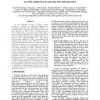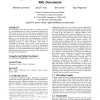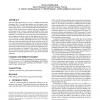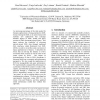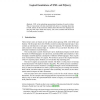DATESO
2010
14 years 5 months ago
2010
The XML format has become the standard for data exchange because it is self-describing and it stores not only information but also the relationships between data. Therefore it is u...
ACL
2007
14 years 8 months ago
2007
The AMI Meeting Corpus is now publicly available, including manual annotation files generated in the NXT XML format, but lacking explicit metadata for the 171 meetings of the cor...
ESWS
2008
Springer
14 years 9 months ago
2008
Springer
With currently available tools and languages, translating between an existing XML format and RDF is a tedious and error-prone task. The importance of this problem is acknowledged b...
BIBE
2001
IEEE
14 years 11 months ago
2001
IEEE
As the eXtensible Markup Language (XML) becomes a popular or standard language for exchanging data over the Internet/Web, there are a growing number of genome Web sites that make ...
XMLSEC
2003
ACM
15 years 15 days ago
2003
ACM
The information on the web is growing at a very fast pace. In this ever-accumulating data, the volume of information represented in XML format is on the rise in recent times. An o...
DOCENG
2003
ACM
15 years 16 days ago
2003
ACM
Since the XML format became a de facto standard for structured documents, the IT research and industry have developed a number of XML editors to help users produce structured docu...
VLDB
2004
ACM
15 years 18 days ago
2004
ACM
An increasing percentage of the data needed by business applications is being generated in XML format. Storing the XML in its native format will facilitate new applications that e...
ACSC
2006
IEEE
15 years 1 months ago
2006
IEEE
Publish/subscribe systems filter published documents and inform their subscribers about documents matching their interests. Recent systems have focussed on documents or messages ...
RWEB
2009
Springer
15 years 1 months ago
2009
Springer
XML is the underlying representation formalism of much web-data. Thus to reason about web-data essentially boils down to reasoning about data in XML format. In this course the stud...
WWW
2009
ACM
15 years 2 months ago
2009
ACM
Since more and more business data are represented in XML format, there is a compelling need of supporting analytical operations in XML queries. Particularly, the latest ver

